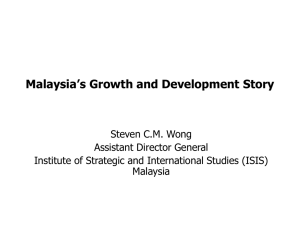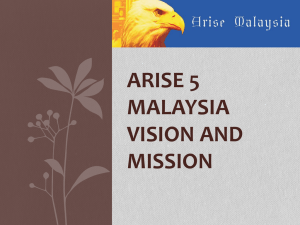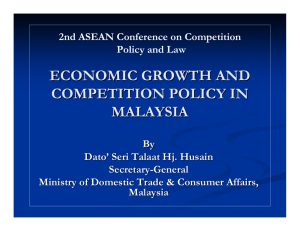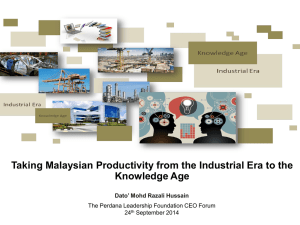Population Change and Environmental Issues in Malaysia
advertisement
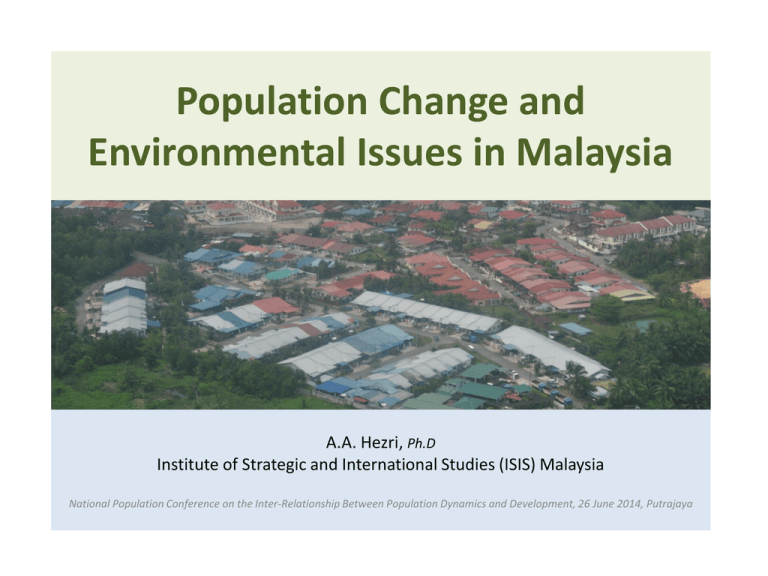
Population Change and Environmental Issues in Malaysia A.A. Hezri, Ph.D Institute of Strategic and International Studies (ISIS) Malaysia National Population Conference on the Inter-Relationship Between Population Dynamics and Development, 26 June 2014, Putrajaya Presentation/Paper Outline 1. 2. 3. 4. 5. The Science of Population-Environment The Politics of Population-Environment Environmental Impacts of Development in Malaysia 3.1. GHGs emissions and energy usage 3.2. Water resources 3.3. Minerals 3.4. Pollution 3.5. Biodiversity 3.6. Solid waste The Interplay of Population-Environment Nexus 4.1. Forest loss in natural resources frontier 4.2. Displacement of forest-dwelling population 4.3. Urbanization and high-density living Concluding Remarks The Science • Mono-causal Malthusian thesis – population growth causes environment depletion • Multiplicative approach – Impact = Population x Affluence x Technology identity • The mediating perspective – policy context, institutions, market, science and culture link population factors with environmental outcomes The Politics • Brundtland SD definition – development that meets the needs of the present without compromising the ability of future generations to meet their own needs • UN International Conference on Population and Development , Cairo 1994 – removal of the population subject from the global policy discourse – population issues were not considered in formulation of the Kyoto Protocol and have also been largely excluded from the Intergovernmental Panel on Climate Change (IPCC) assessment reports Environmental Impacts of Development The state-of-the environment is altered from a pristine nature to a modified human landscape in just one century 600000000 500000000 400000000 300000000 200000000 100000000 0 Biomass Construction minerals Fossil fuels Metal ores and industrial minerals Figure 1: Material Flow Malaysia, 1970-2008 Population and consumption as two elephants in the room Environmental Impacts of Development • GHGs emissions and energy use – Malaysia appeared in the bottom-ranked group of countries alongside Canada, Australia, the USA and Saudi Arabia in the Climate Change Performance Index – 91% growth in metric tons of CO2 emissions from 1994-2004 (c.f. 36% South Korea, 69% Thailand, 275% Vietnam) • Water resources – Malaysians use an average of 226 litres of water a day, compared with 155 litres and 90 litres in neighbouring countries Singapore and Thailand respectively • Minerals – Resurgence of minerals extraction e.g. iron ore causing public anxiety Environmental Impacts of Development • Pollution – In 2011, the Department of Environment reported that 39 rivers were polluted, 3,177 open burning cases were lodged, and about 12 illegal disposals of scheduled wastes were still practiced by unscrupulous offenders • Biodiversity – IUCN Threatened Species List : Malaysia ranked as the country with the third-highest number of endangered species – Since 1960s, backed by powerful economic forces, a number of key wildlife protected areas have been rescinded to give way to agricultural land use in Peninsular Malaysia • Solid waste – Generation of municipal solid waste in Malaysia has increased more than 91% over the past 10 years Interplay of Population-Environment Nexus 1. Forest loss in natural resources frontier – Land cover dynamics. Large scale agriculture in the 20th century. Recently, Cameron Highlands 2. Displacement of forest-dwelling population – Land alienation and other forms of socio-economic marginalization have undermined the population and identity of Malaysia’s indigenous tribes 3. Urbanization and high-density living – Pathology of high-density living or the impact of crowding on social behavior Malaysian Peculiarity The flow of urbanization interstate for five years, 1980 to 1985 Concluding Remarks Population-environment nexus is under-studied in Malaysia. Three proposals: i. ii. Rapid appraisal of related research Mapping of population-environment hotspots - e.g. demographics of disaster-prone areas iii. Regional security analysis of ‘environmental or climate refugees’ and how Malaysia should deal with this challenge Thank You !






